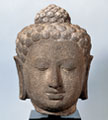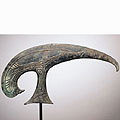 |
|
 |
 |
 |
 |
 |
 |
 |
 |
Sculpture from Indonesia
Indonesia is made up of over 13,500 islands and is home to many different ethnic groups. The complex relationships between the various islands and peoples in this part of the world and the impact of the culture of other Southeast Asian countries and India on those of Indonesia are still being deciphered by art historians. Most of the Asia Society's objects come from Java, one of the largest of the Indonesian islands and the site of spectacular architectural monuments such as the famous temple-mountain Borobudur. Other objects in the collection were created on Sumatra or another island under the patronage of the Shrivijayan empire, which ruled over western Indonesia and parts of the Thai/Malay peninsula from about the 7th through the 13th centuries. By the 5th century, Hindu kingdoms existed on Java and a number of other islands, although by the 8th century, Buddhism dominated many parts of the archipelago. However, by the end of the 9th century, Hinduism regained prominence in Java and Bali although in Sumatra, Buddhism appears to have been the most popular religion from the 7th century onwards. In the 12th century, Arabic traders introduced Islam to Indonesia and today the country has the world's largest Muslim population. |
 |
 |
| 1 thru 7 of 7 |
 |
| view text only list |
 |

Standing Figure |
 |

Buddhist Goddess |
 |

Head of Buddha |
 |

Bodhisattva Avalokiteshvara |
 |

Four Vajra-Deities |
 |

Vajrasattva |
 |

Ceremonial Ax |
 |
|
 |